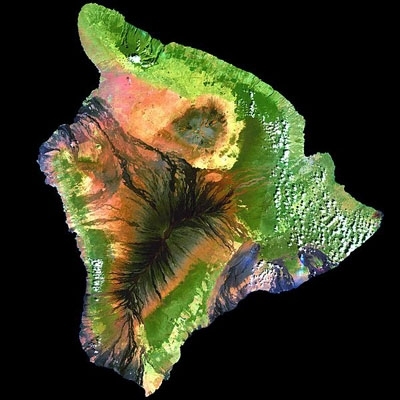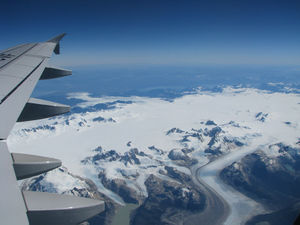Biogeography
Biogeography is the study of the spatial distribution of biological organisms. The scale of analysis ranges from very small micro-topography regimes to continental dimensions. Fundamental concepts in this field of study are the nature of barrier formation and response of species in their patterns of travel and migration; in particular, the presence of rivers, mountain ranges, deserts and other natural boundaries are examples of large scale barriers. Besides such major landform barriers, there are soil, topographic andmeteorological factors that influence the distribution of each species. In the case of smaller scale regimes that are applicable for some bacteria or limited range plantspecies, there are often very restricted niches; for example, certain bacteria extremophiles may be limited to such localized features as small geyser pools, and some rare plants may have a single extant colony defined specialized soils such as serpentine and narrow climatic zone. Inherent in the concept of biogeography are the processes of speciation, extinction, dispersal and migration.
Contents
Island biogeography
One of the easiest geographical regions to visualize is an island, since boundaries are clearly defined by the surrounding water body that prevents most species from in or out migration. Charles Darwin gained many insights from island obervations in the Galagopos and other settings, and modern theorists have used the island geometry to deduce useful ecological relationships. The best known of these quantitative deductions is the scaling of number of species with the island area.
Natural barriers and taxon distribution
Generalizing from the notion of island biogeography, one can imagine any set of natural barriers as effective delimiters of a species distribution; in fact, the barriers need not be mechanical in nature such as a mountain range or lava flow. Ecological barriers can be more subtle, such as transition of soil pH, microclimate or range of a predator.
The range of a species is typically time variant, with fluctuations in food and water availabiltiy being chief determinants. In addition, the concept of distribution is linked to home range size in the case of animals, since the faunal range is influenced by the need not only to secure adequate territory , but also to enable an overall species density to enable ready finding of a mate.
When physical or environmental separation isolates taxa for a long time period, a species can develop phenotypic differentiation from other species members; this process usually occurs upon one or more mutation events that produces DNA material which enables the new phenotype to adapt better to the environment than its ancestors; the entire process can be considered as speciation and natural selection. When the species distribution is drastically reduced from a predecessor larger range, the population is often termed a relict population and the shrunken range is termed a refugium.
Global and evolutionary view
Using plant biodiversity as a surrogate for global organism species richness, one observes that approximately thirty percent of flowering plant species are distributed extremely broadly: twenty percent are concentrated in temperate regions; and fifty percent are concentrated in the tropics. The classic biogeography argument is that higher tropical sunlight intensity and higher temperatures have fostered elevated metabolic rates, which in turn have promoted greater numbers of [[mutation]s], simply by statistically reducing time between generations. Evidence from theFossil record also suggests that the greater tropical biodiversity has endured for many millions of years.
A complicating argument suggests that glacial advances of the five Ice ages have disrupted habitats, but also caused significant habitat fragmentation. Thus, periodic destruction of habitats has been greater in temperate regions, enhancing the tropical productivity argument; however, periodic fragmentation may have actually enhanced speciation by creating long term glacial separations of metapopulations, thus allowing subpopulations to develop independently, having to adapt to distinct [[microclimate]s] and habitats. However, temperate regions are not the only areas that have been severely glaciated during the peaks of glacial advance, so that even regions like Amazonia are thought to have been significantly fragemented by glaciers over the last 545 million years. All things considered, these cosmic arguments generally provide a basis for high tropical biodiversity, but suggest that the entire picture may be much more complex. For example, we know that endemism at the genus and higher taxonomic level can be generally higher in the desert regions than in the tropics.
Compounding the complexity, there are two purely geometric arguments that explain higher tropical biodiversity. Firstly, there is a simple calculation of land area available, based upon the fact that effective area decreases with each successive higher latitude. Next, there is a random patch argument (called the Mid-domain theory) that suggests that, if species were distributed randomly, there are necessarily more opportunities for overlap at the lower latitudes.
Altitude effects on biodiversity
Numerous studies have been conducted to analyze the correlation of species diversity with altitude. The most consistent results have been found in the tropics and subtropics in the case of vascular [[plant]s]. Depending on the precise region studied, research has demonstrated a peak of species richness at mid-level altitudes, which peak exceeds both the very low and very higher elevation biodiversity. The peak occurs between 1500 and 2500 meters, depending on the specific world region being studied. These effects may be explained simply on the basis that rainfall maxima tend to occur in mid-altitude zones, so that the increased metabolic and shortened generations argument leads to greater speciation. Other researchers have attempted to apply this theory to sub-surface ocean environments, but results have shown mixed outcomes.
References
- Robert H. MacArthur, Edward O. Wilson. 2001. The theory of island biogeography. Princeton University Press. 203 pages
- Pierre Dansereau. 1957. Biogeography: An Ecological Perspective. Ronald Press, New York, USA. ISBN 0826023304.
- C.Barry Cox and Peter D. Moore. 2010. Biogeography: An Ecological and Evolutionary Approach. John Wiley and Sons. 506 pages
- G.C.Stevens. 1989. The latitudinal gradients in geographical range: how so many species co-exist in the tropics. American Naturalist 133, 240-256.



0 Comments